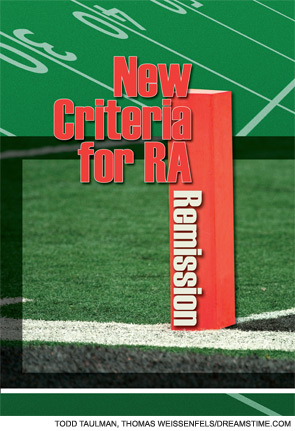
The ACR and the European League Against Rheumatism (EULAR), in cooperation with members of the Outcome Measures in Rheumatology (OMERACT) initiative, have completed the first comprehensive provisional definition of remission in rheumatoid arthritis (RA) for clinical trials since 1981.1 The criteria are designed to distinguish true remission from even minimal disease activity. They provide clear endpoints for clinical trials as well as treatment goals that rheumatologists and their patients can pursue. The new criteria will enable doctors to better evaluate patients’ conditions, as well as patients’ prospects for achieving remission or, alternatively, for achieving minimal disease activity.
Reasons for the Update
One key reason that old criteria needed updating is that they were very stringent; treatments were so much less effective in the 1980s that very few patients could meet the criteria for remission. Additionally, the old definition contained elements not in the core set of disease activity measures, such as morning stiffness and swelling in tendon sheaths. These problems led to development of many modifications of the criteria by various interested parties, which created considerable confusion in the field, says Maarten Boers, MD, PhD, professor of clinical epidemiology and biostatistics at VU University Medical Center in Amsterdam, the Netherlands, and a coauthor of the new criteria.
Moreover, the old definitions of remission frequently had problems. By one of the most popular sets of criteria, which uses the Disease Activity Score (DAS), a patient could be categorized as “in remission” and yet have substantial residual disease activity in joints that are included in that score, says Dr. Boers.
This did not matter much to those in clinical practice, however, because patients so rarely achieved remission by any definition, points out David Felson, MD, MPH, professor of medicine and epidemiology at Boston University School of Medicine, and a coauthor of the new criteria.
Indeed, in the U.S. and Western Europe in the early 1980s, the prospects for patients were similar to what currently prevails in lower-income countries today, “where you can see the types of disease activity that my generation of rheumatologists grew up with,” says Dr. Boers. At that time, patients “were walking around with six to 10 swollen and 15 to 20 painful joints. We gave them gold, put them in clinics, and the joints were slowly destroyed,” he says.
But now, “with the advent of new therapies and therapeutic strategies … remission has become a realistic goal, and has recently become a secondary or even primary endpoint for clinical studies and trials,” according to the “ACR/EULAR Provisional Definition of Remission in RA for Clinical Trials.” The definition points out that “remission is also regarded as a major therapeutic target in clinical practice and can be achieved in a significant proportion of patients followed in routine care.”

